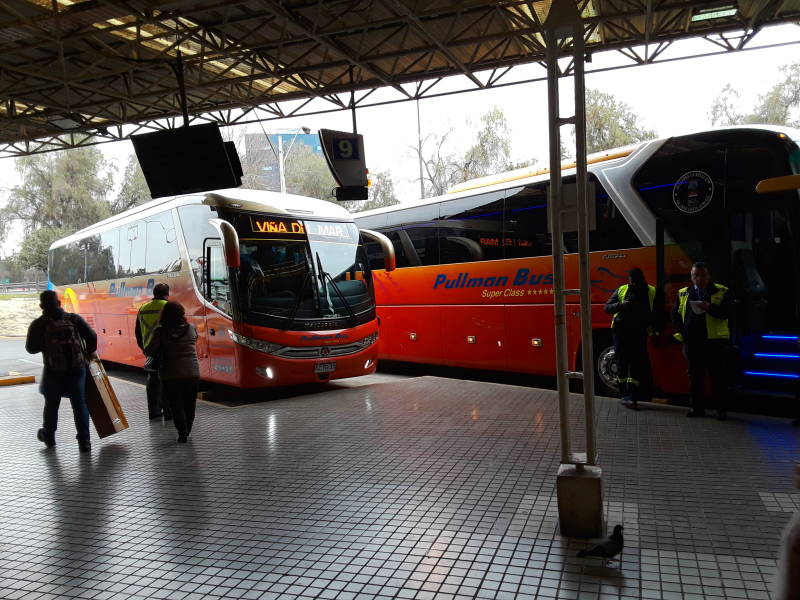
Santiago
Santiago
My friends asked me if I would be at all interested in
going to Chile to experience the
2019 solar eclipse.
¡Si!
Flights between the US and Chile tend to be overnight in
both directions.
So, there's a lack of decent sleep.
But the good news is that there's no time shift.
Chile is in the same time zone as eastern North America.
But the seasons are opposite.
The eclipse was on July 2nd, mid-winter in Chile.
Temperatures in central Chile got down to a few degrees
above freezing overnight.
Santiago is in the Central Valley, the western slopes of
the Andes are at the edge of the city.
The Andes are covered with snow this time of year.
Winter in summer, the Moon in front of the Sun,
off I go!

My flight was delayed. Scheduled to leave Atlanta at 2230, Delta had concluded around 0100 that they needed to give up on fixing the B767-300 we were loaded into and move us to another aircraft. And of course by around 0200 they realized that the crew would be over their maximum duty hours. So, they passed out blankets and everyone bedded down in the Atlanta airport concourse for a non-restful night, before flying out at 0700. At least we got to see the Caribbean and parts of Ecuador, Peru, and Chile in daylight. That got me into Santiago around sunset, instead of soon after sunrise.
The lower coastal range between Santiago and the Pacific was covered with clouds when I arrived late on a dark and wet day.

Barrio Brasil
I had reserved a bed at Happy House Hostel in Barrio Brasil. I got there after dark, so I didn't appreciate its architecture until the next morning.

I found Barrio Brasil to be a very nice area to stay. Happy House is just three blocks from the end of the bus line from the airport, and the Los Héroes Metro station. There's a university in the neighborhood, and plenty of restaurants and bars. It's a great area to wander, taking in the architecture and street art.
The current Lonely Planet guide to Chile expresses confusion over why people like Barrio Brasil, when instead they could be paying US$ 200 and up for rooms in US chain hotels with embedded spas.
That night I had just seen the nice lobby area, with skylights in atria.
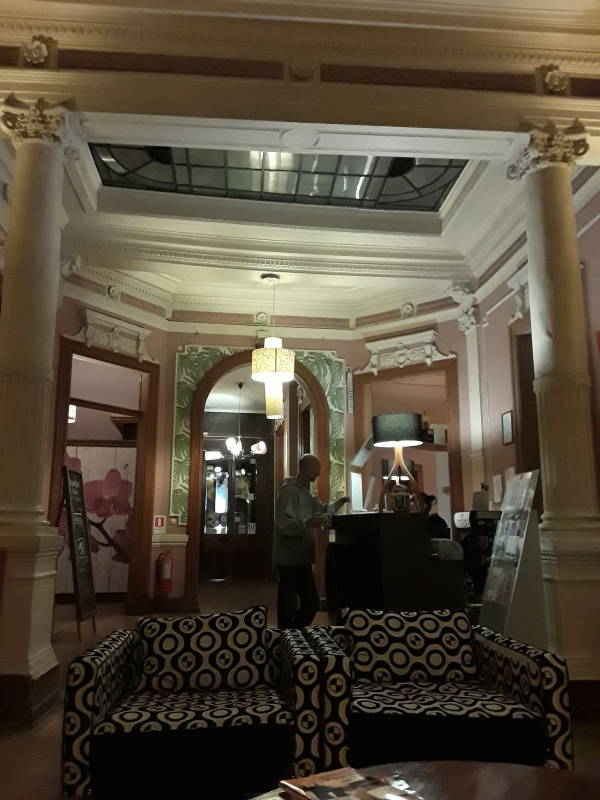
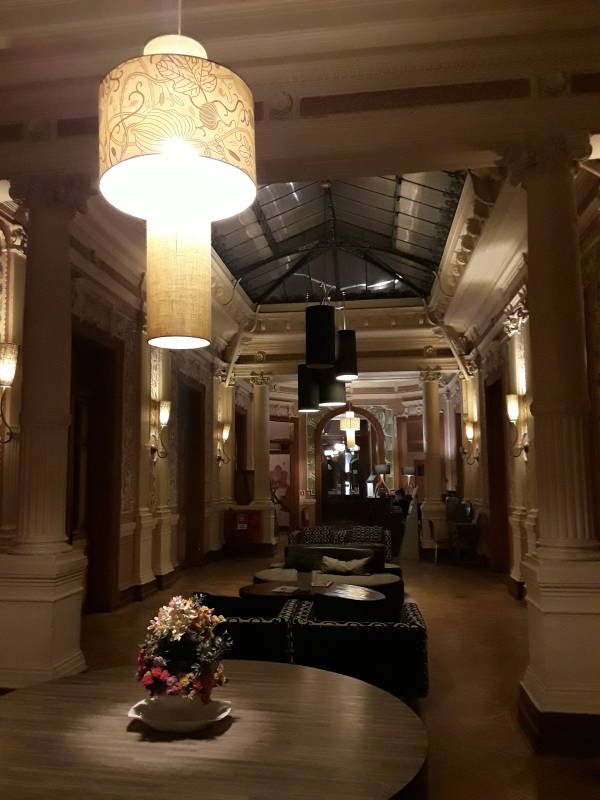
Chile
I dropped my things in the room, then went out for a late dinner. There was a nice little picada or pica nearby, Chilean for a local hole-in-the-wall eating or drinking spot, with great food and atmosphere. Pollo y papas fritas y ensalada, con futbol.
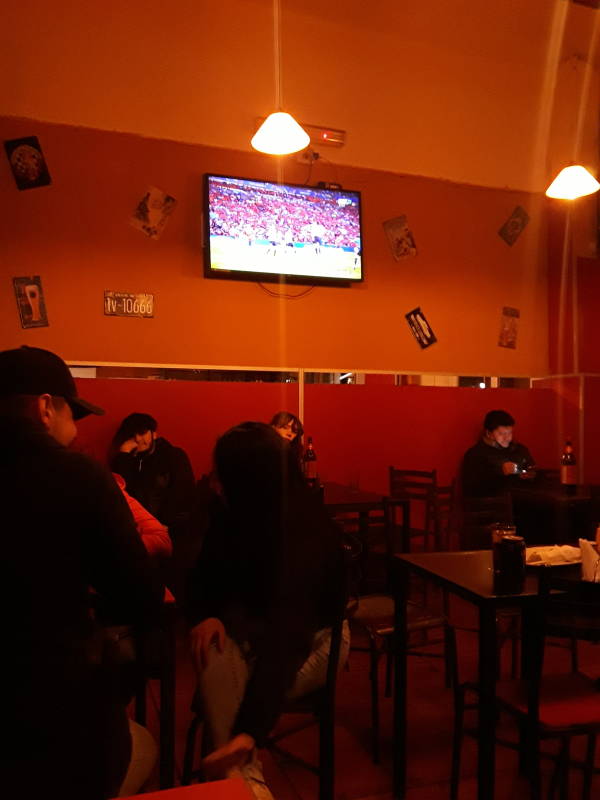
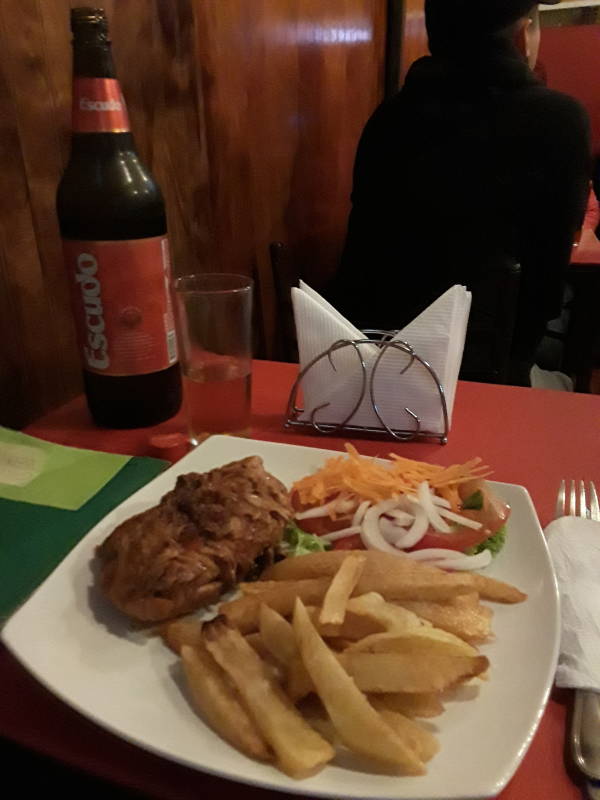

Then, back to the Happy House.

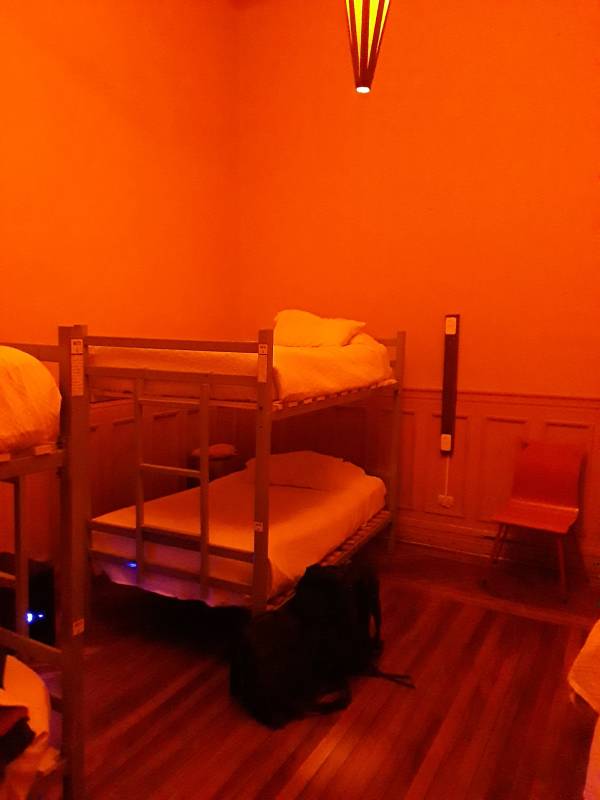
As I found throughout Chile, budget places didn't have much central heating. But they provided plenty of blankets, so the beds were cozy.
Breakfast downstairs was great. And, also common in Chile in the winter, there was a portable heater.

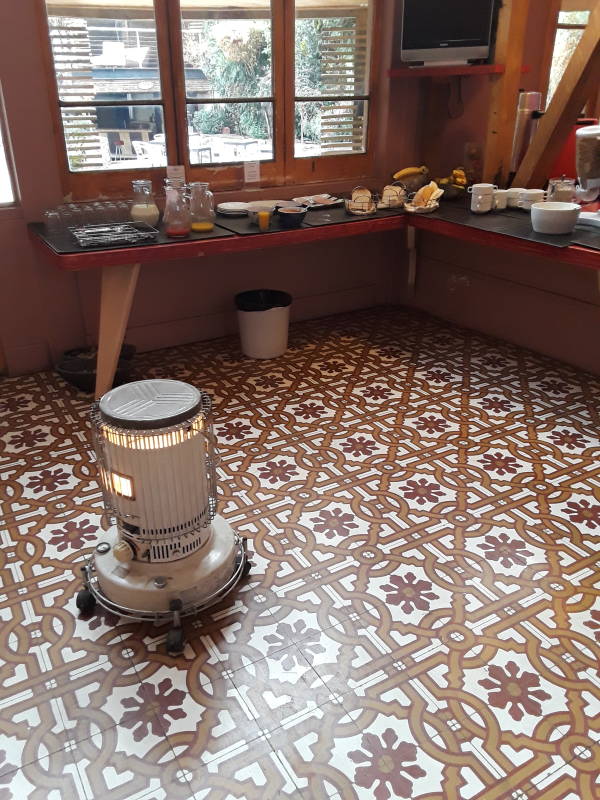
I'm out for my first day of tourism in Chile!
Right across the street, I started seeing some great architecture.


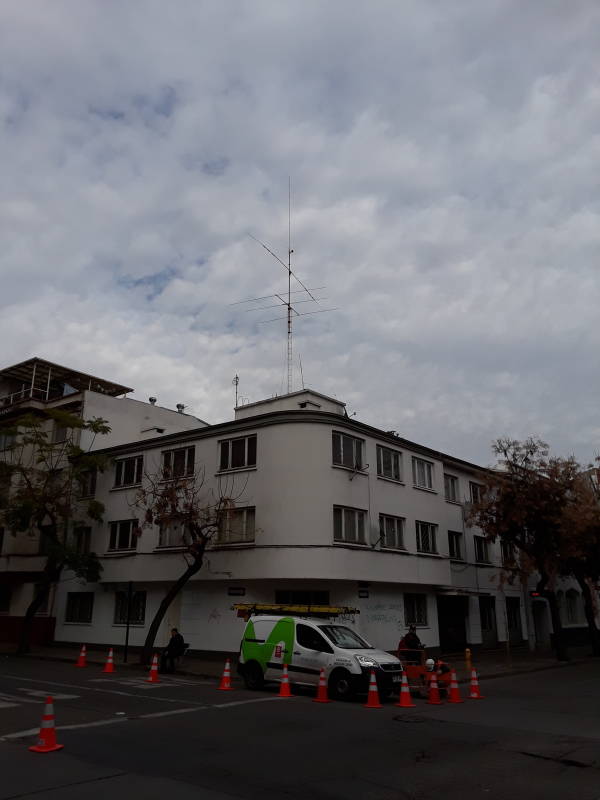
And, electromagnetics. The next corner down, the southwest corner of Moneda and Cienfuegos, had what looked like a 15 meter Yagi and 30 meter dipole.
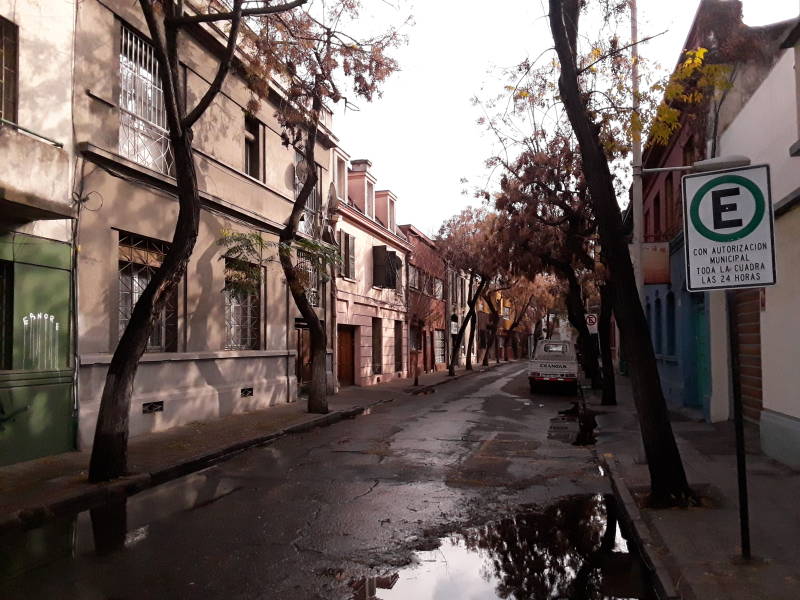
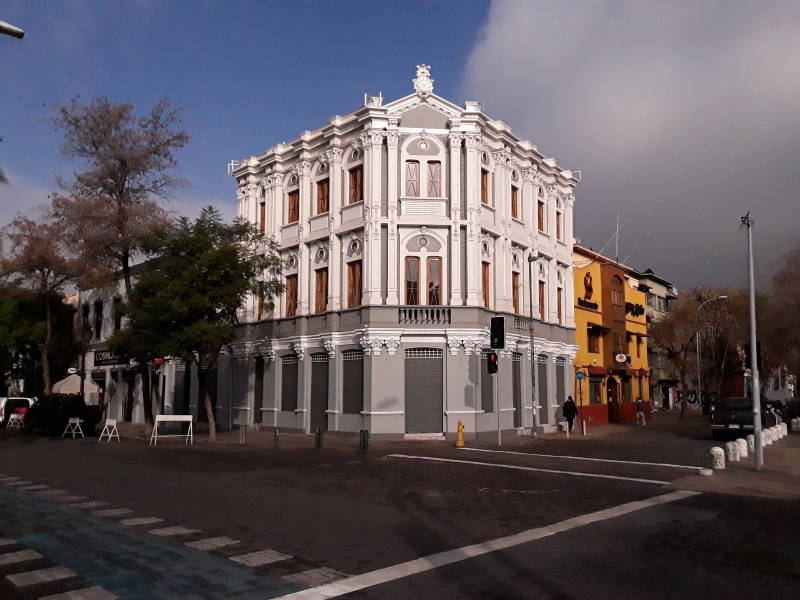
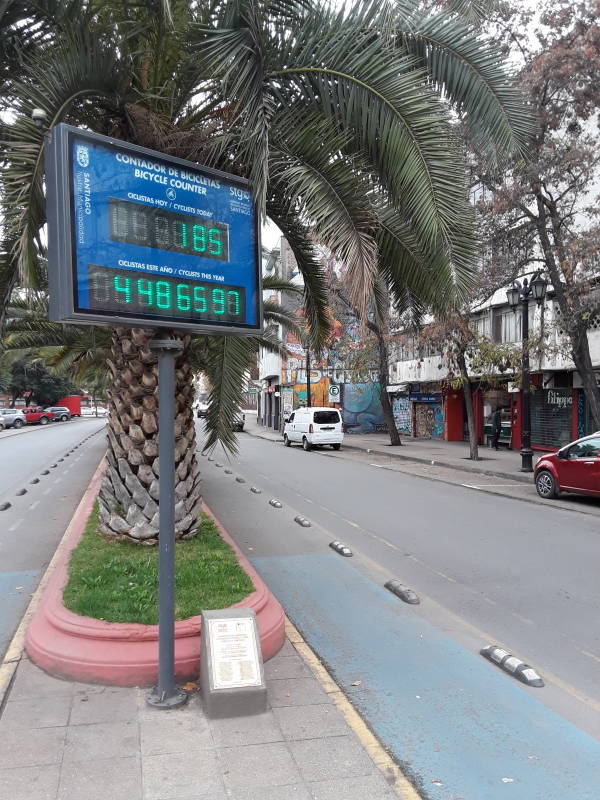
A counter at the corner of Plaza Brasil kept track of bicycle traffic. It's showing 185 bicycles so far today at 10:44 in the morning, in the middle of winter. And, about 4.5 million half-way through the year. That's a lot of bicycle traffic!
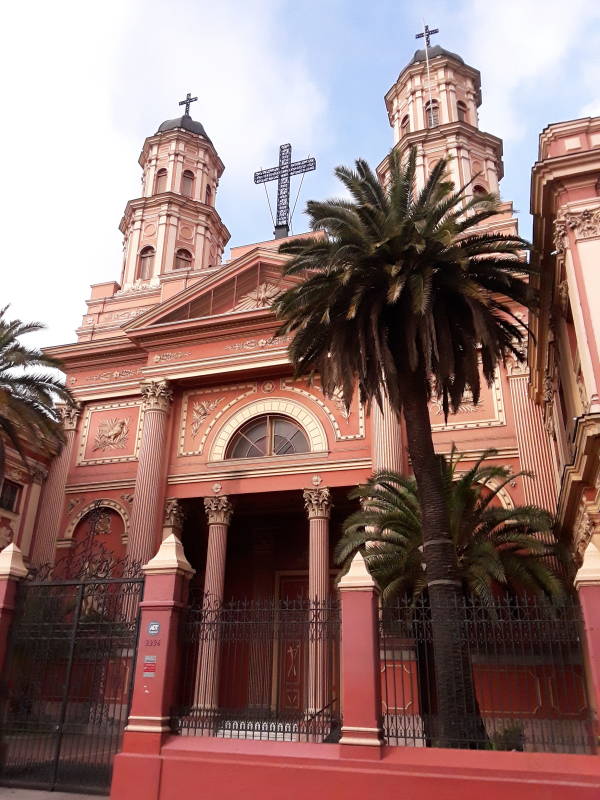
Chile has had some horrible recent history. Augusto Pinochet took power in a US-backed military coup d'état in 1973, overthrowing the democratically elected government of President Salvador Allende. Pinochet imprisoned up to 80,000 people, tortured tens of thousands, and executed from 1,200 to 3,200 victims. Current government estimates favor the high ends of the ranges, or even higher.
Guided by the "Chicago Boys", a group of Chilean economists who had studied under Milton Friedman and Arnold Harberger, Pinochet imposed changes that led to a dramatic increase in economic inequality and the 1982 economic crisis, Chile's worst since the Great Depression. Meanwhile, Pinochet himself made a fortune through real estate deals, embezzlement, tax fraud, and possibly commissions on arms deals, hiding his fortune in dozens of secret bank accounts overseas.
Pinochet was voted out of office in a referendum in 1989 and relinquished power in 1990.
Now the police seem to be respected. But they aren't feared. "Cultivo Secreto" is a cannabis grow shop located right next door to the police station in the white building.

I wandered through Barrio Brasil taking in the architecture and street art.
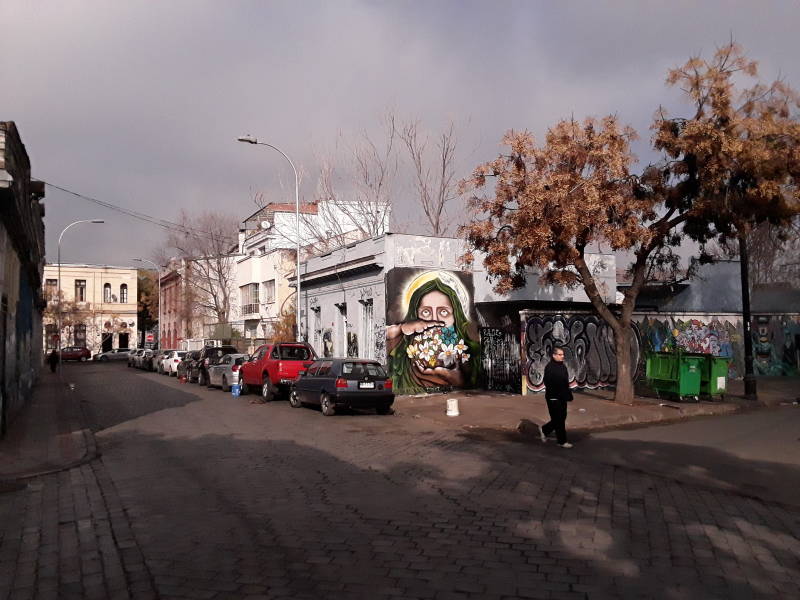

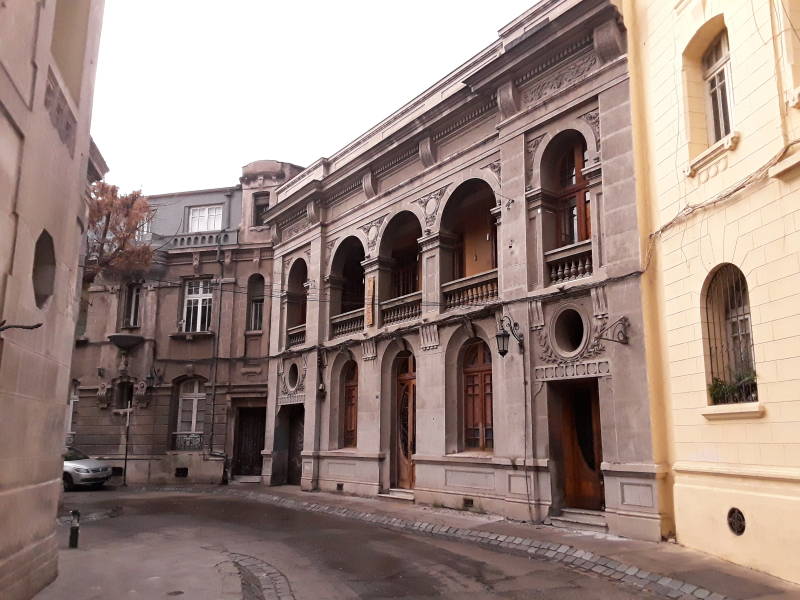


I noticed throughout Chile that architects are credited. Most buildings have plaques naming their designers.
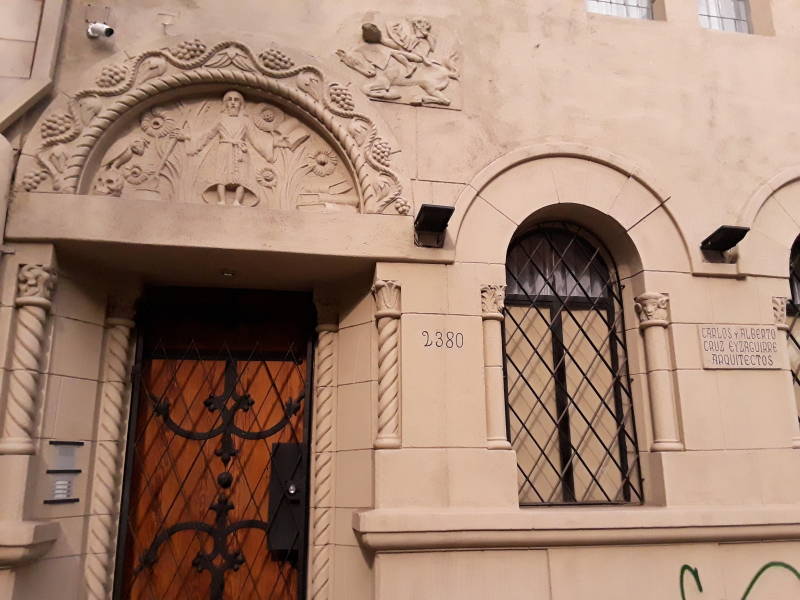
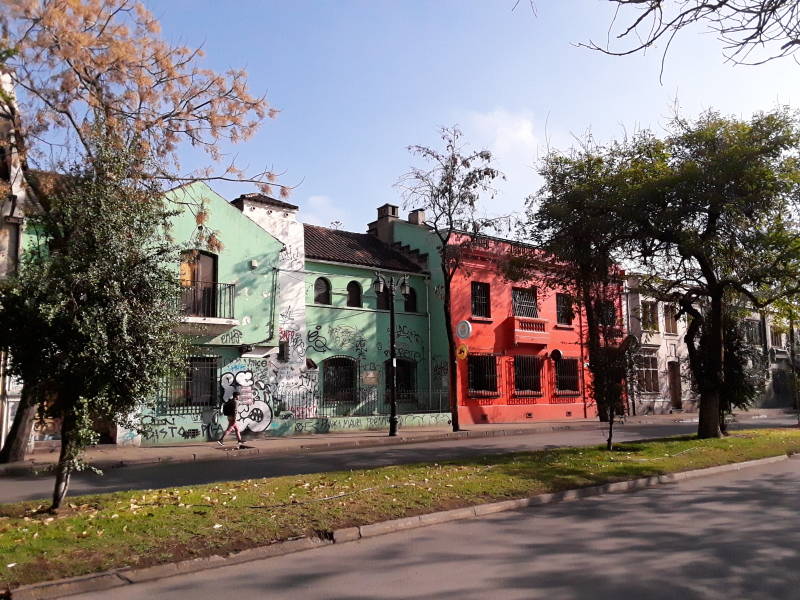

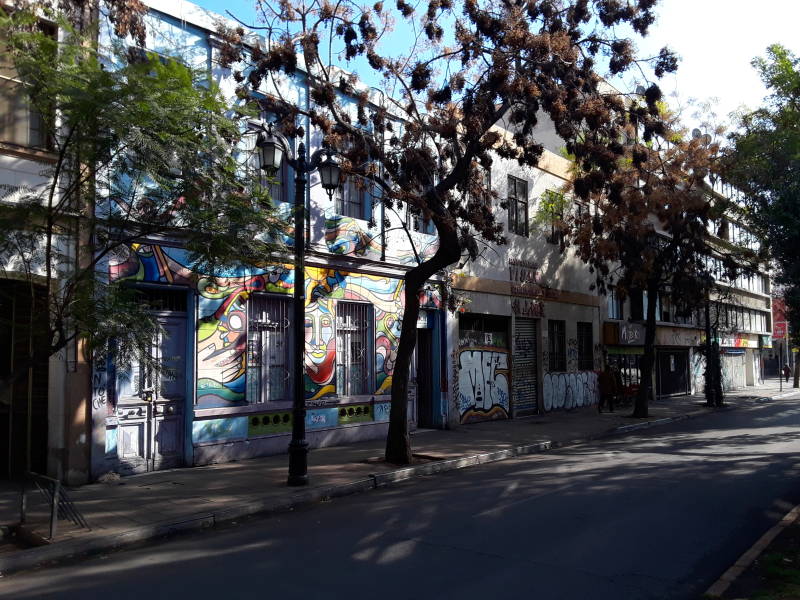
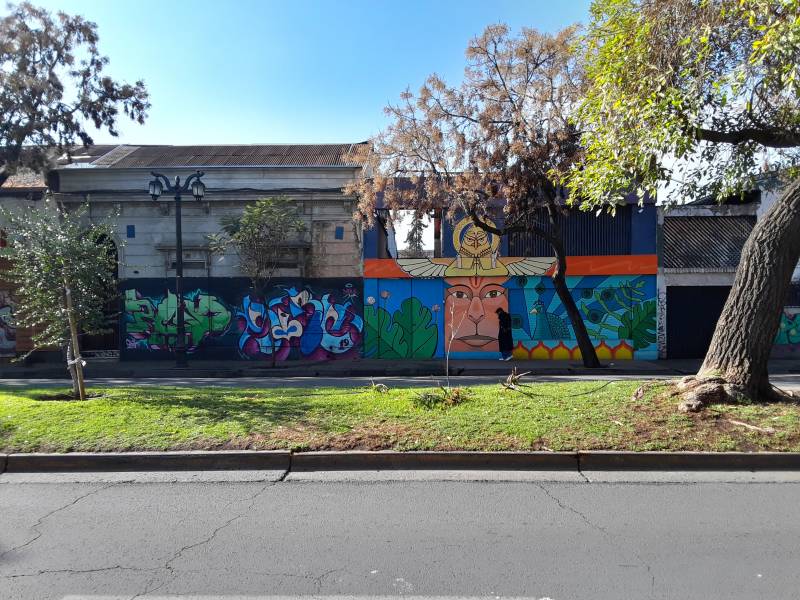

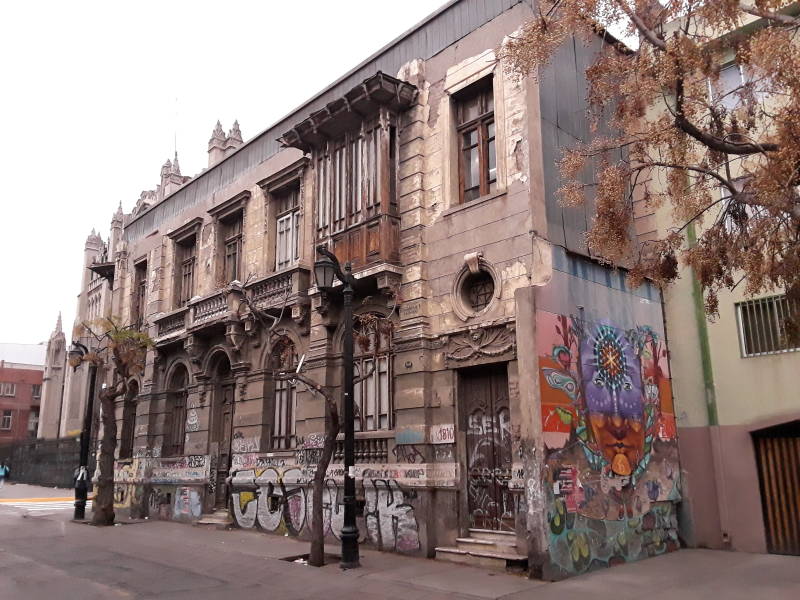

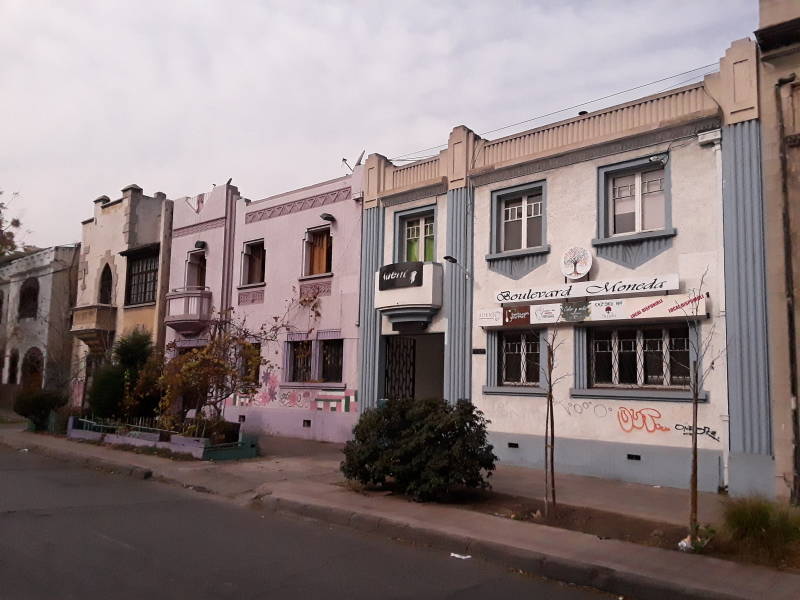


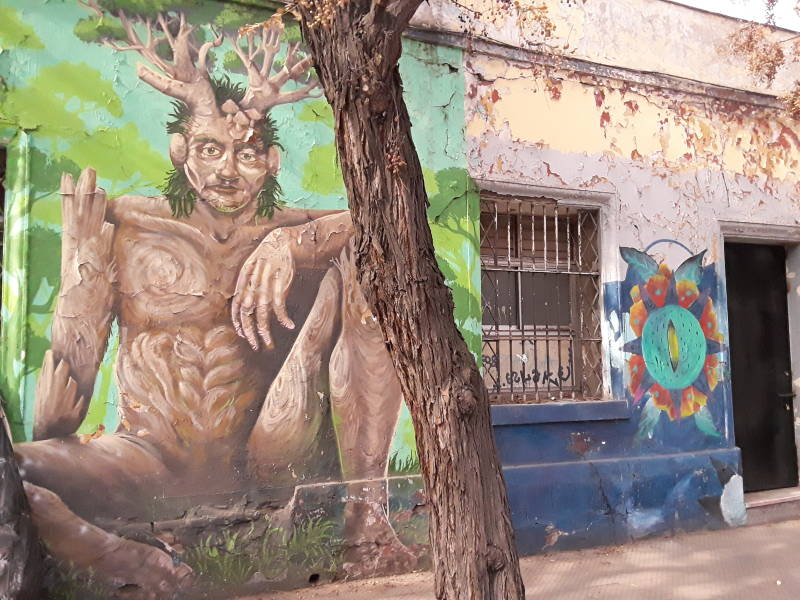
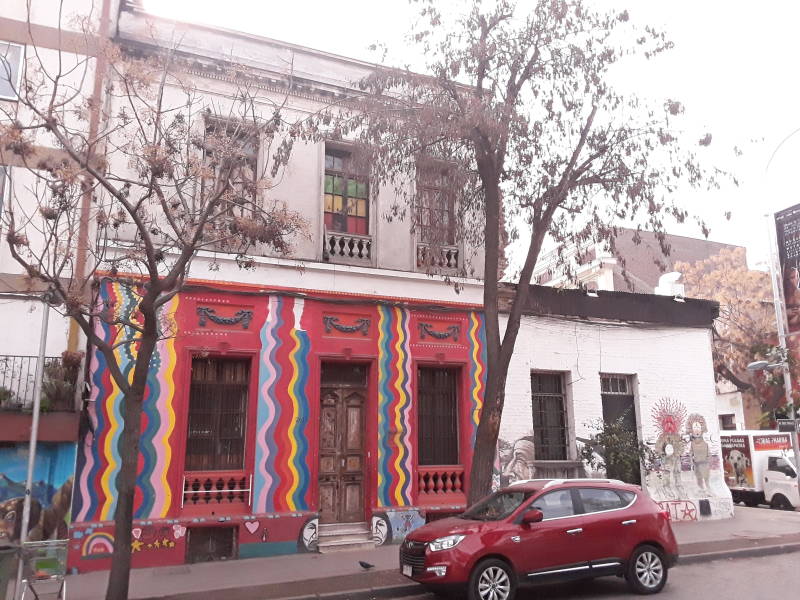
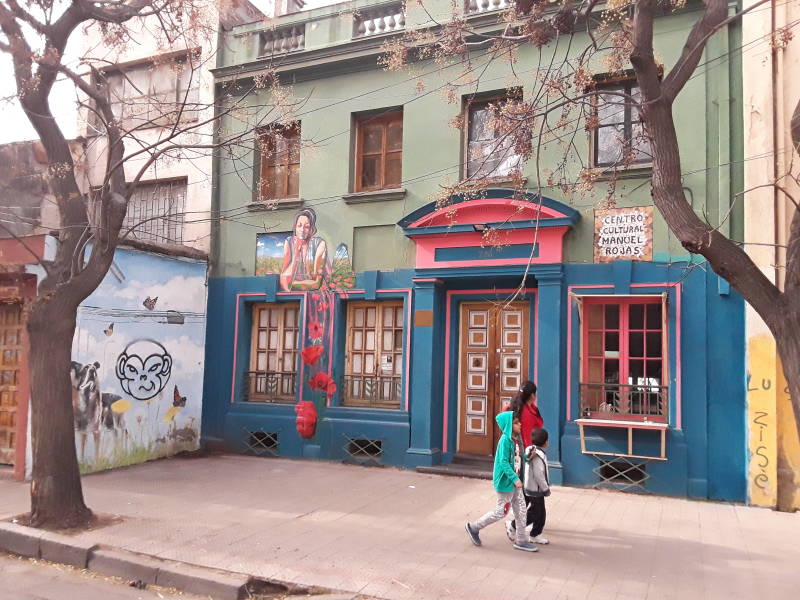
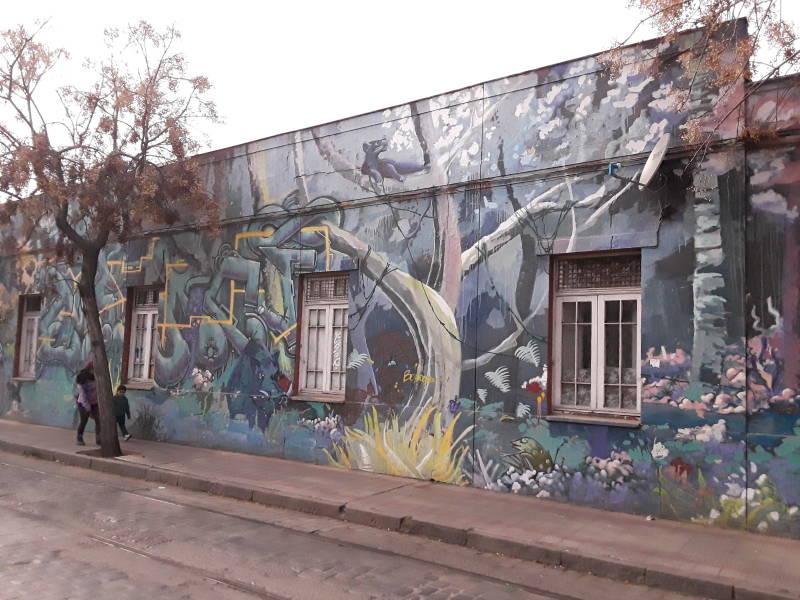
Estación Central
I went to Estación Central to check on train schedules for later travel. Outside the narrow streets of Barrio Brasil, the snow-covered Andes are visible east of the city.
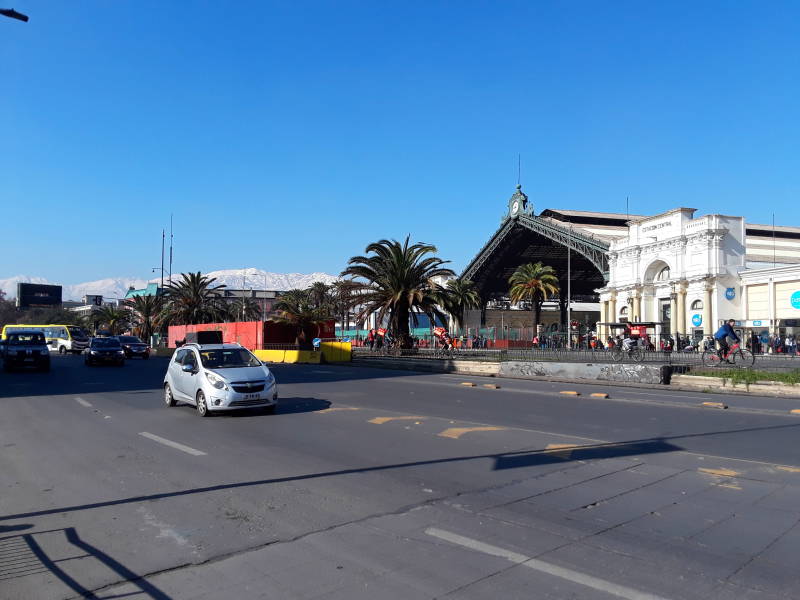

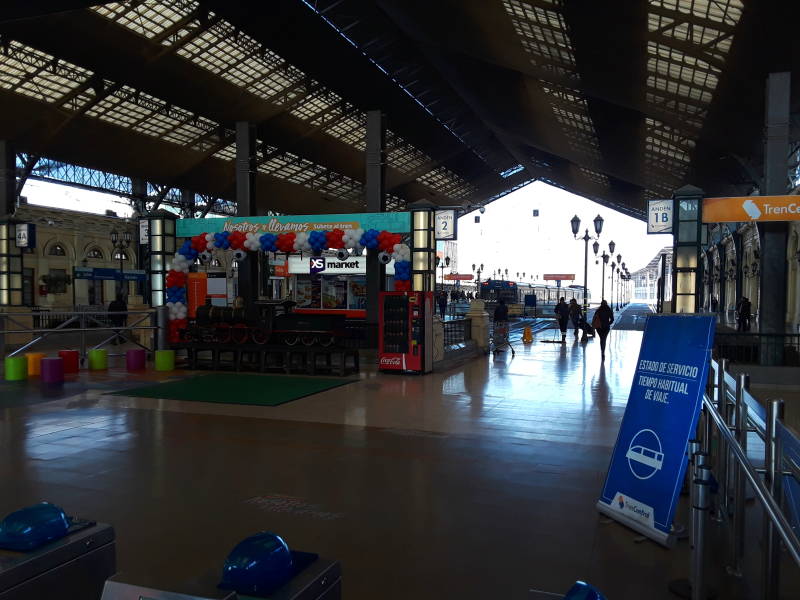
Metro
Next, I got on the Metro. Santiago's subway was named the best system in the Americas. It carries around 2.5 million passengers every day.

The trains are based on the units used on the Paris Metro and Mexico City Metro.

Plaza de Armas
I passed the Academia Diplomatica de Chile on my way to the Plaza de Armas.
It seems that every city in Chile has a central Plaza of the Army and a grid pattern of streets numbered out from that square.
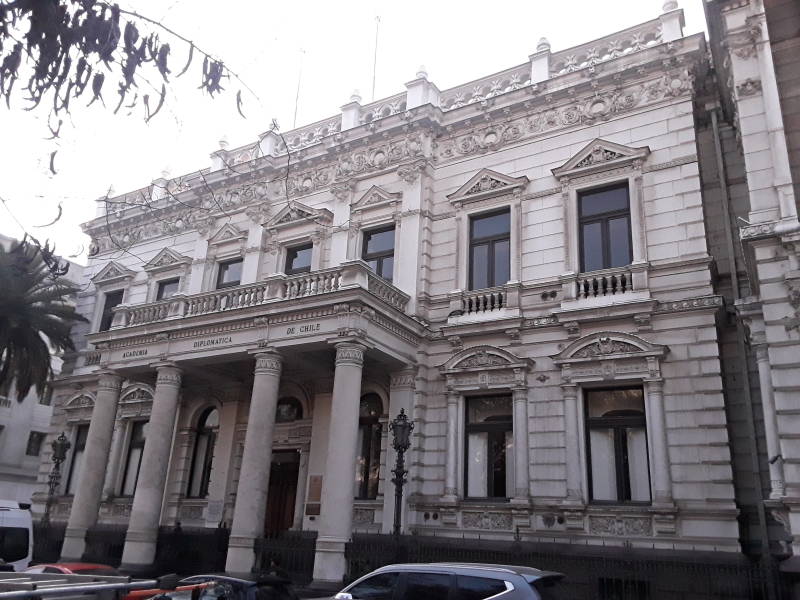
La Piojera has a long history, it first opened in 1896.
It got its name in 1922, when friends of President Arturo Alessandri Palma took him to what had become a very popular bar among Santiago's working class. He had been claiming to represent the proletariat, so he should go to their dive bar.
He famously was disappointed, saying "Y a esta piojera me han traído!?" or roughly "And I have been brought to this fleahouse!?" The name La Piojera stuck.
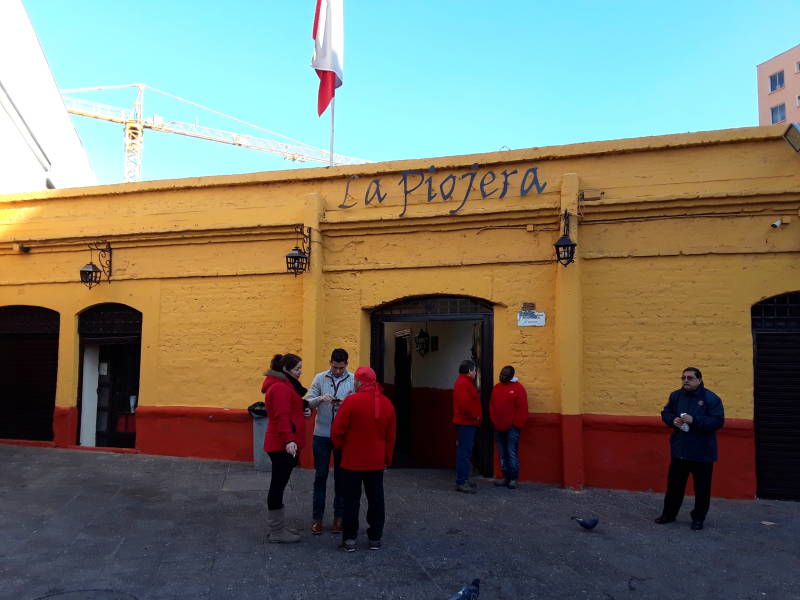
The signagure drink is el Terremoto or the Earthquake. It's made with pipeño sweet white wine, Fernet (a bitter herbal spirit about 45% A.B.V.), bitters, and grenadine, topped by pineapple ice cream.
A large one is called the Cataclismo. They may limit you to just one, at which point you have to switch to the smaller Réplica which lacks the Fernet.
Mind you, this is in Chile, where they know their cataclismic earthquakes.
Fernet is Italian, but 75% of global consumption is in Chile, which has the only Fernet distillery outside Italy.
La Piojera remains a favorite of Chilean poets, musicians, and social activists.
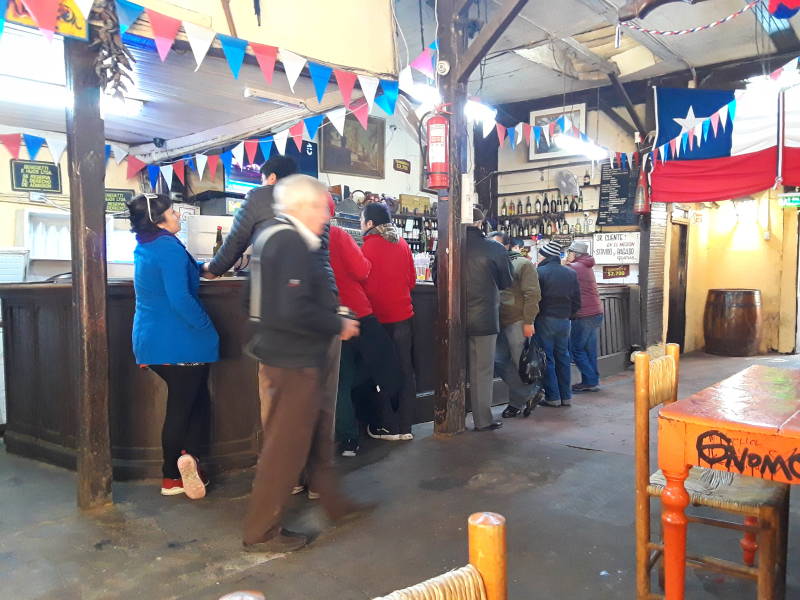
I had a chicha to start. Chile has two main types of chicha: apple chicha produced in southern Chile, like this one, and grape chicha produced in central to northern Chile. Both are alcoholic beverages produced with fermentation only, no distillation.

Then ensalada y empenada.
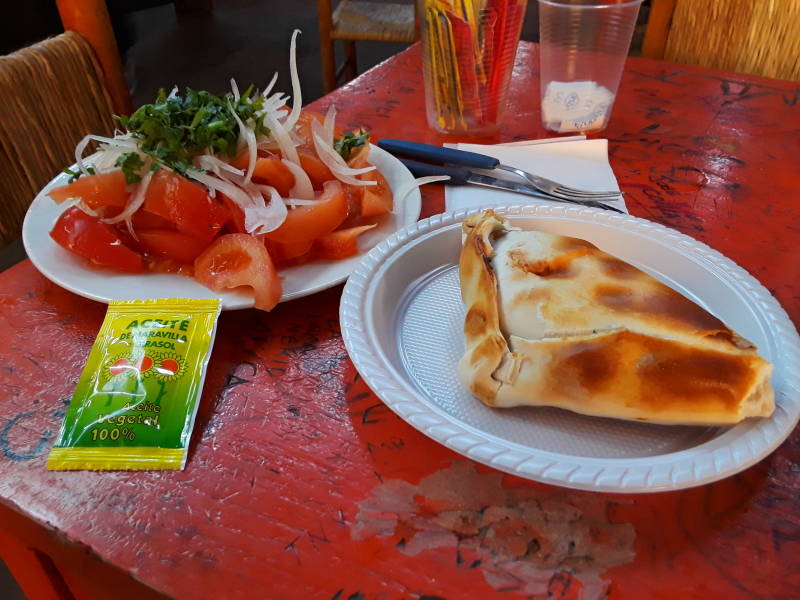

From here I circled around to the south of Plaza de Armas, through some shopping arcades.
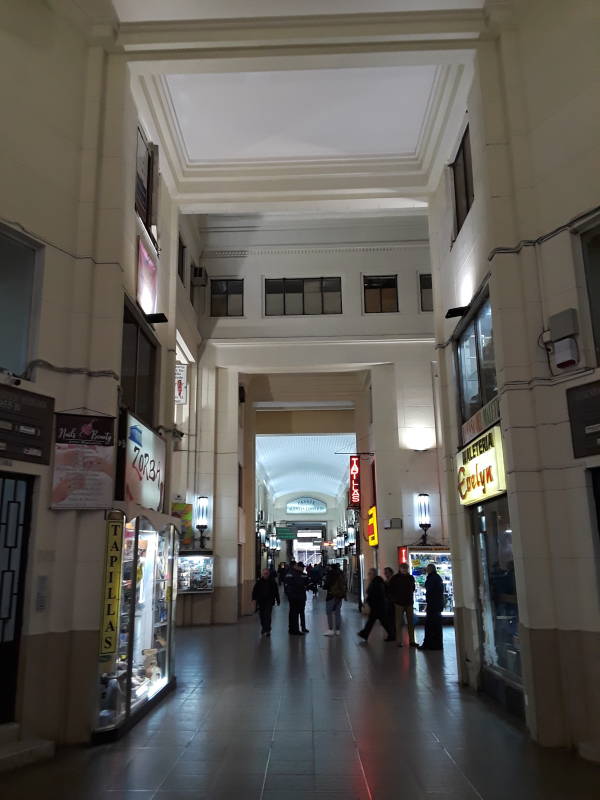

The Metropolitan Cathedral of Santiago is at the northwest corner of the plaza.
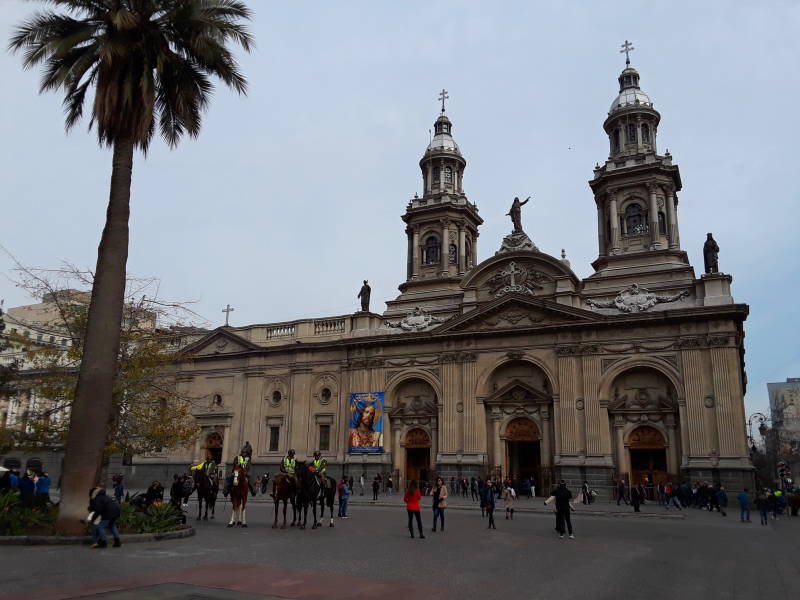
Mexico
It's elaborate inside, but not as elaborate as I had expected.
I was expecting the over-the-top Spanish baroque style that you find in Mexico. Chilean churches were nice, less ornate and gaudy than I had expected.
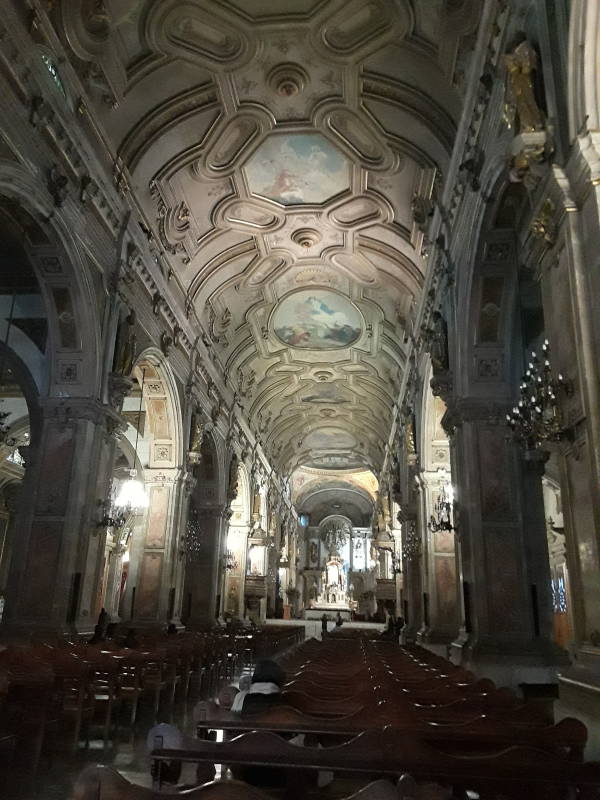
Across the northwest corner from the cathedral is the Correo Central or the Central Post Office.

Chile is a largely post-postal society. Postcards, and the stamps with which to mail them, are antiquated 20th century concepts.
But if you manage to find postcards somewhere, and you want to mail them, you will need to find the filatelia office within the post office.
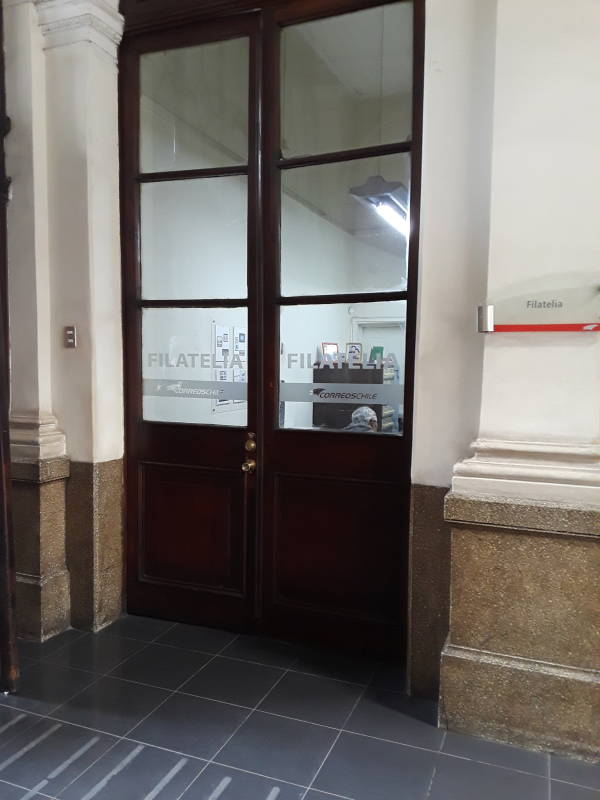

The main lobby, where most people know nothing about stamps, is a grand atrium topped with a skylight.
Off the back corner of the atrium is the Museo Postal Telegrafico.
This teletype unit was used to send radiograms between Santiago and Punta Arenas, near the southern tip of Chile, between 1950 and 1970. It's next to a National HRO receiver.
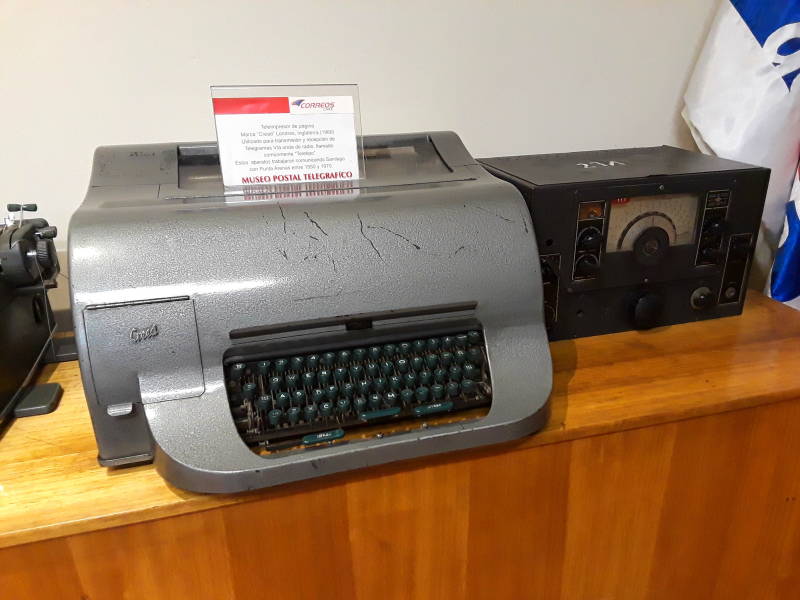
A case displays many telegraph keys and sounders from the history of Chilean telecommunication.
Morse codeA display on the adjacent table describes in detail how you could send "SOS" on the nearby straight key.
• • • − − − • • •
The docent wanted to make sure that I saw that,
and took the opportunity to try to send SOS.
I pounded out
CQ CQ CQ DE KC9RG KC9RG K
at about 20 wpm.
¡Con entusiasmo!

Here are two pieces of test gear, an oscilloscope and what looks like a grid dip meter, plus what I think is a Hallicrafters receiver.

Plaza Constitución
Continuing south, I come to Plaza Constitución.
Chile had been a rare beacon of stability and democracy for decades in South America. The rest of the continent was plagued by dictators and military juntas while Chile had been holding democratic elections since 1932. Then the US-backed 1973 coup became one of the most violent events in Chile's history.
The Palacio de La Moneda, the former mint, was serving as the seat of the President and housed the offices of three cabinet ministers. During the military coup d'état on September 11, 1973, the Chilean Army tasked the Chilean Air Force with bombing the palace in parallel with the Army's assault by armor and infantry.
Travel inSyria
In the late 1970s, Hefez al-Assad had the Syrian military assault one of the country's cities. But at least it wasn't the national capital, and it didn't target the seat of an elected leader.
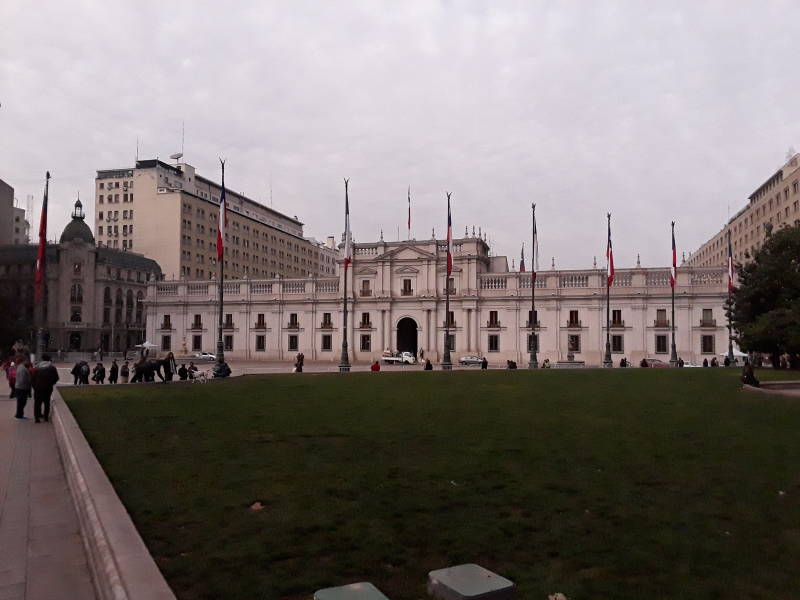
President Salvador Allende refused to resign, citing his constitutional duty to remain in office. He gave a farewell speech, telling the nation about the coup d'état and his refusal to resign his democratically elected office under military threat. He then committed suicide, rather than surrender.
A statue of Allende now stands at the southeast corner of the plaza, near the northeast corner of the palace. It's directly across from what used to be the Ministry of Justice but has since been renamed the Ministry of Justice and Human Rights.
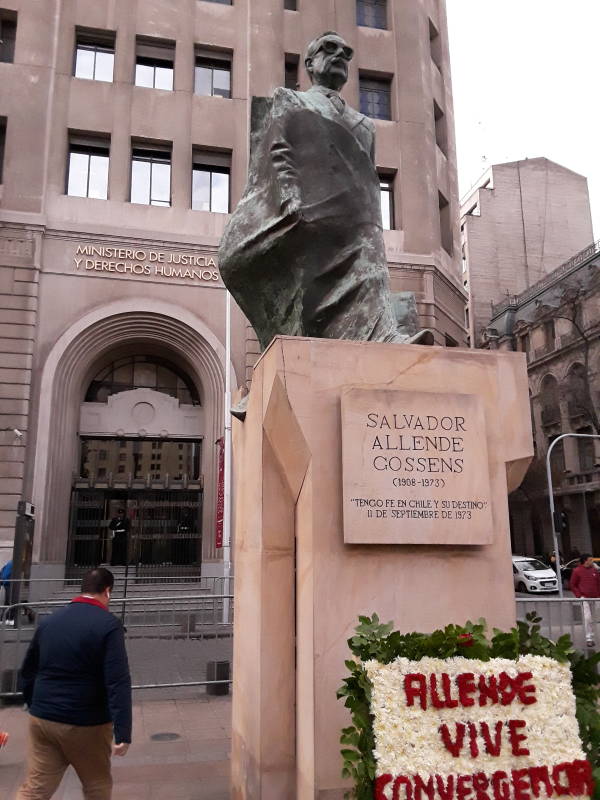
I continued to the east from the Plaza de Armas area.

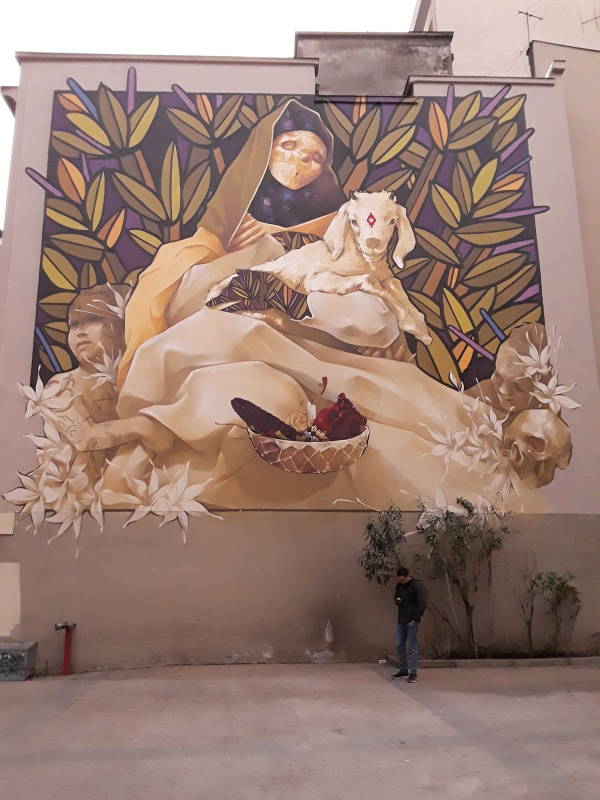
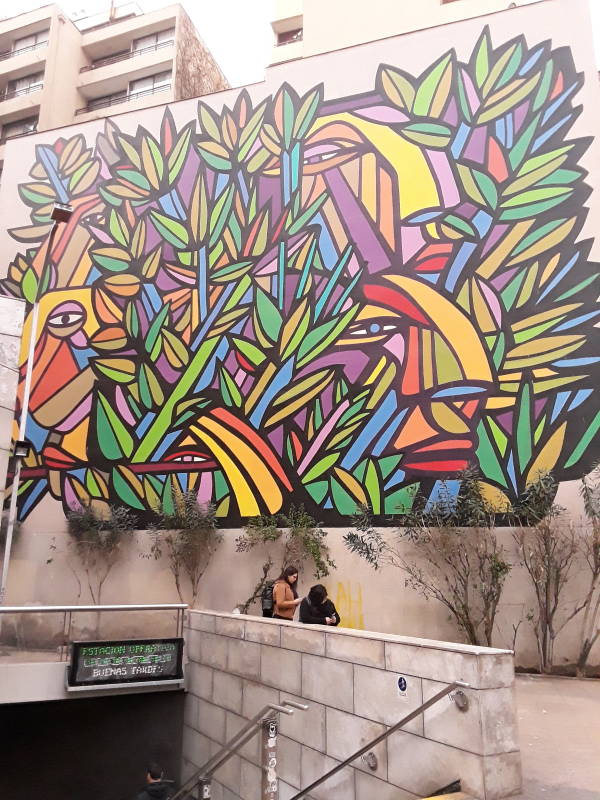
Cerro Santa Lucia
Cerro Santa Lucia is an isolated rocky hill in central Santiago. Late in the afternoon it provides nice views over the city to the Andes.
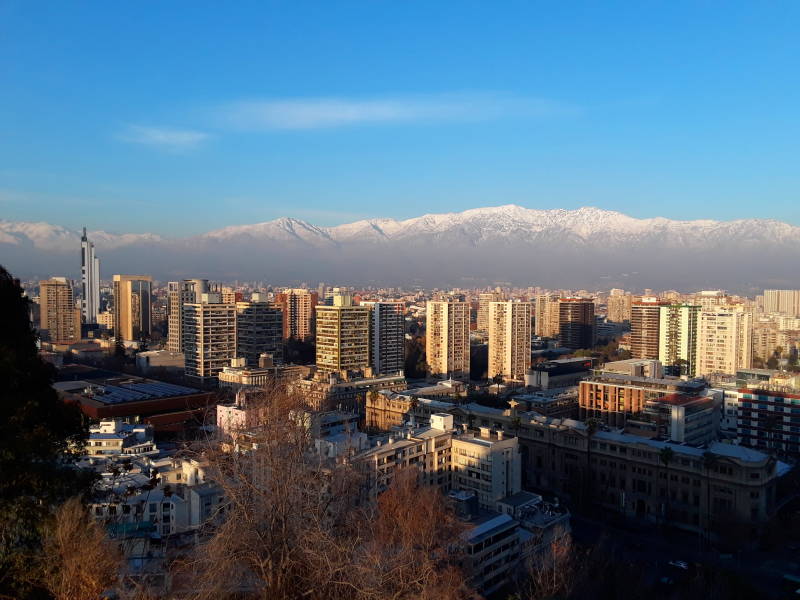
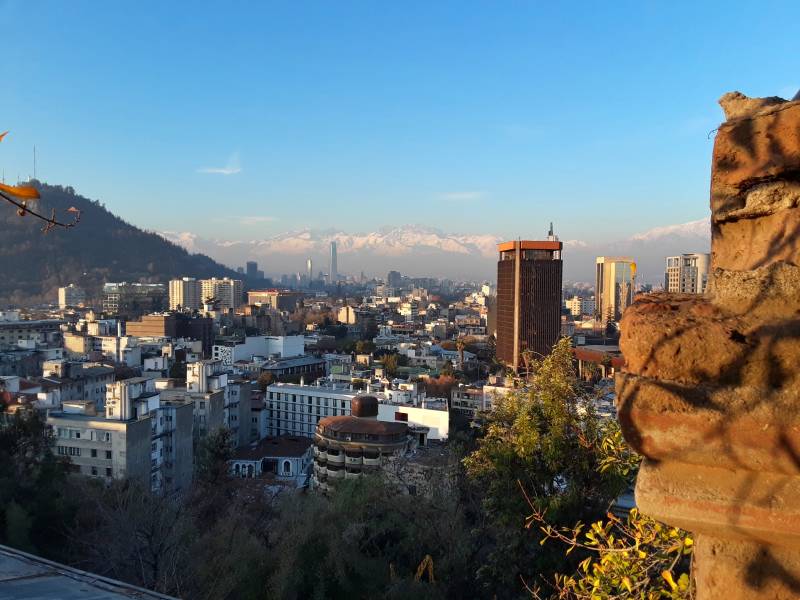
Barrio Bellavista
Continuing toward that larger isolated hill partially visible above takes me across the river into Barrio Bellavista.
Like Barrio Brasil, it contains a lot of street art.
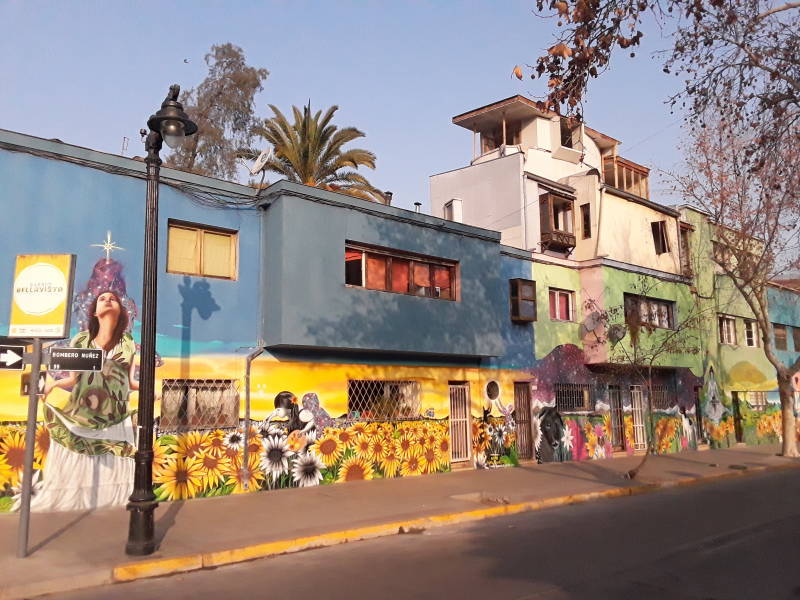

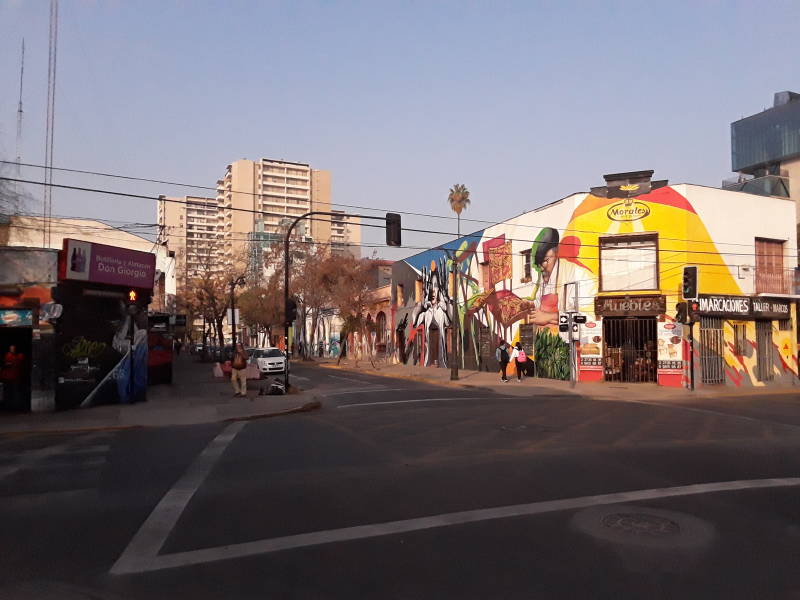
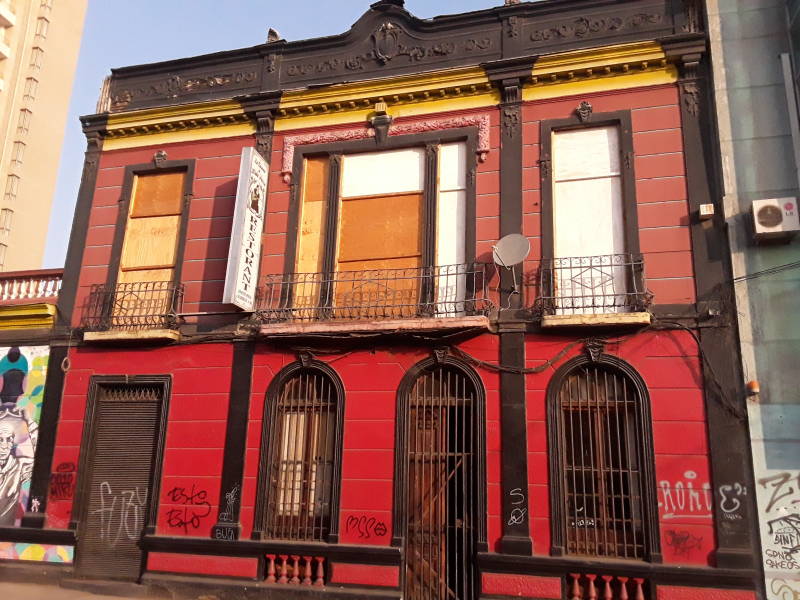
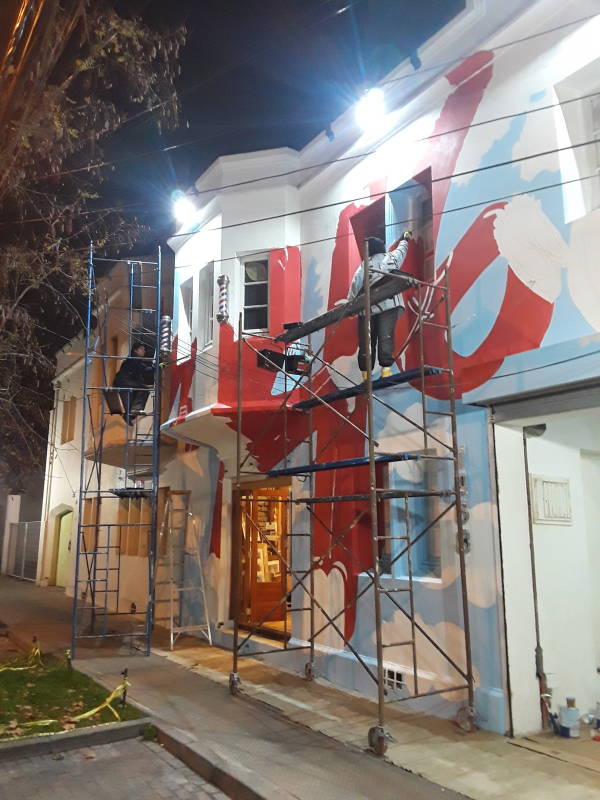
They're out in the evening adding more!
Avienda O'Higgins and the World's Most Beautiful Auto Parts Stores
Almost every city in Chile has a main avenue named Avienda O'Higgins.
Bernardo O'Higgins is considered one of Chile's founding fathers. He was one of the primary leaders who freed Chile from Spanish rule.

Everywhere I went in Chile, there were auto parts stores. Many of them, especially in Santiago, happened to be in beautiful old buildings.

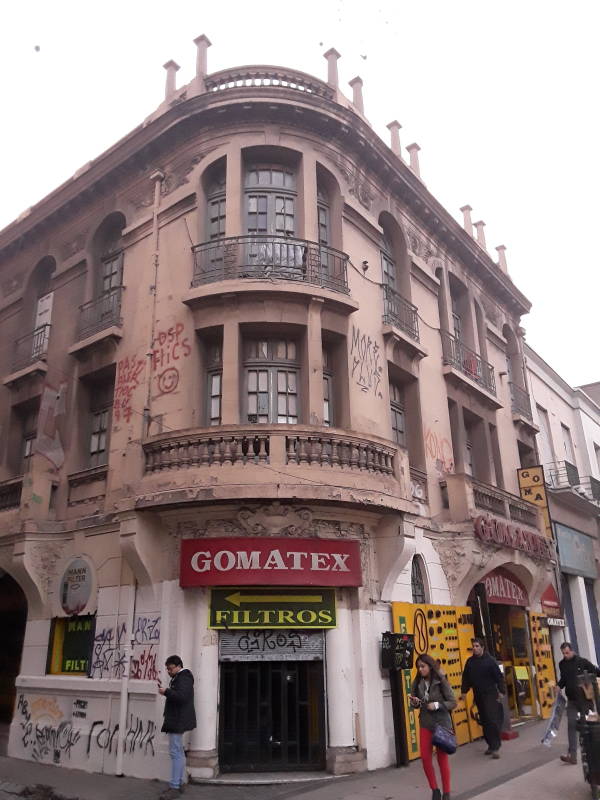
Bernardo O'Higgins was the illegitimate son of a Spanish officer who had been born in Ireland and became governor of Chile and viceroy of Peru.
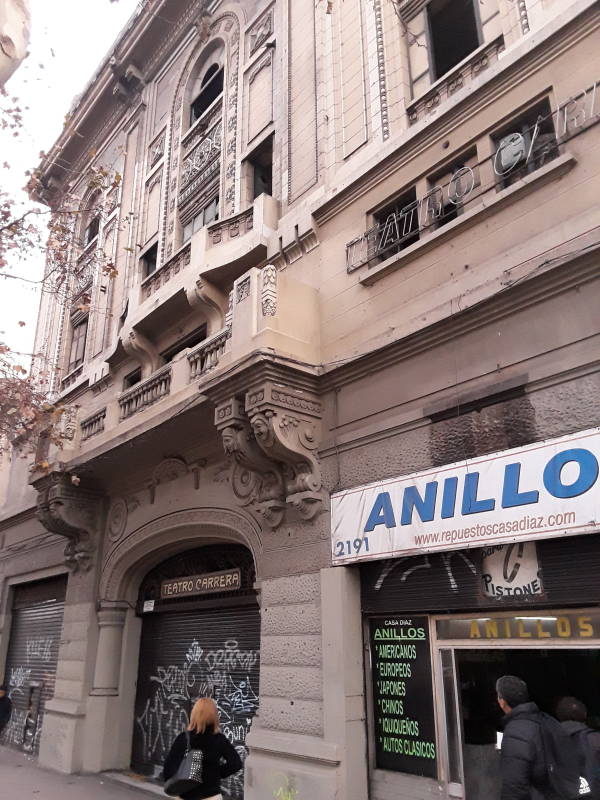
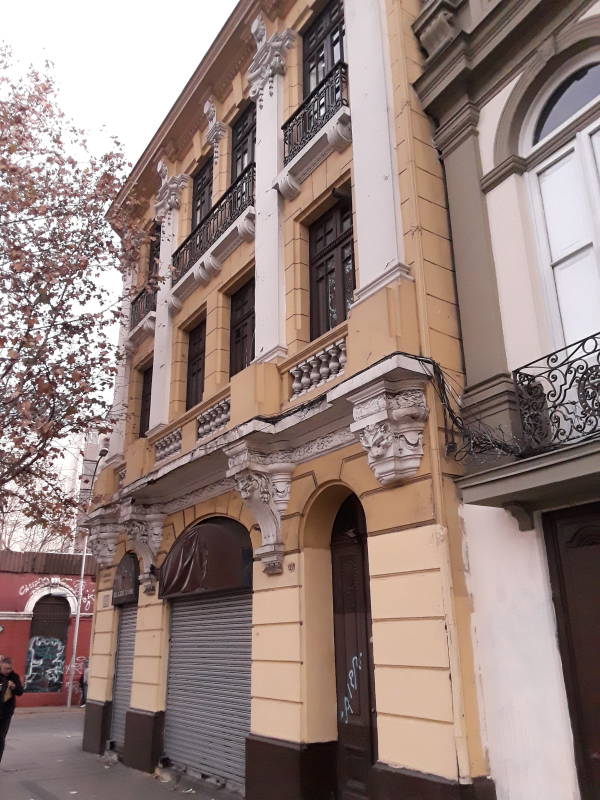
The Chilean War of Independence started in 1810, and lasted at least through 1821 when royalist forces were defeated. Or, depending on how you classify things, until the last Spanish troops surrendered and the Chiloé Archipelago was incorporated into the Republic of Chile in 1826. Spain finally formally recognized Chilean independence and established full diplomatic relations in 1844.
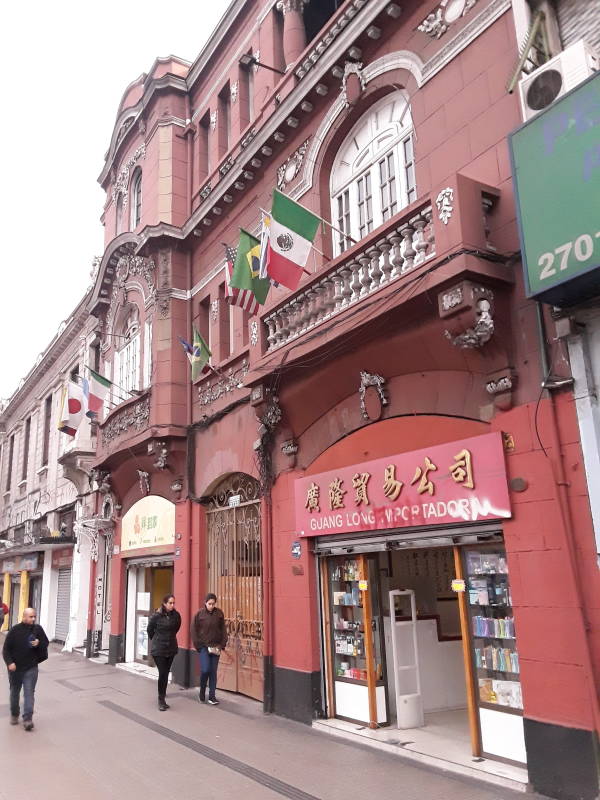
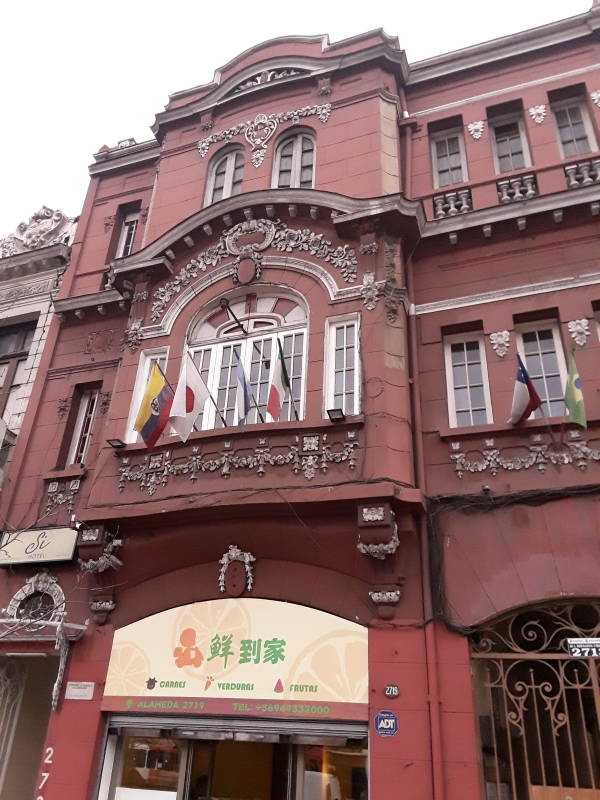
O'Higgins was the Supreme Director of Chile from 1817 until 1823. He established markets, systems of courts, colleges and libraries and hospitals. He founded the Chilean Military Academy, the modern Chilean Navy under the command of the Scottish officer Thomas Cochrane, and the Chilean Marine Corps.
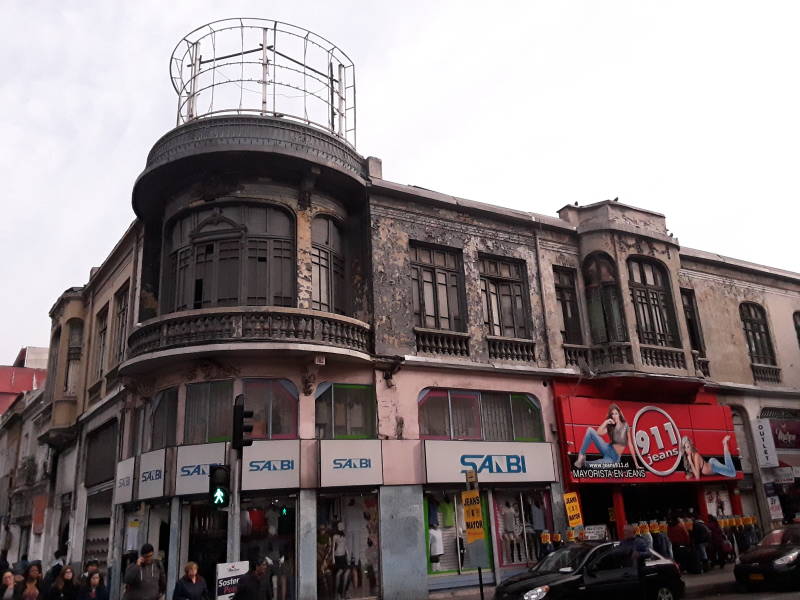
But along the way he alienated the aristocracy by proposing liberal reforms such as democracy and the abolition of titles of nobility. He also offended the Bishop of Santiago.
With the Aristocracy and the Church against him, O'Higgins was deposed in a conservative coup in 1823.
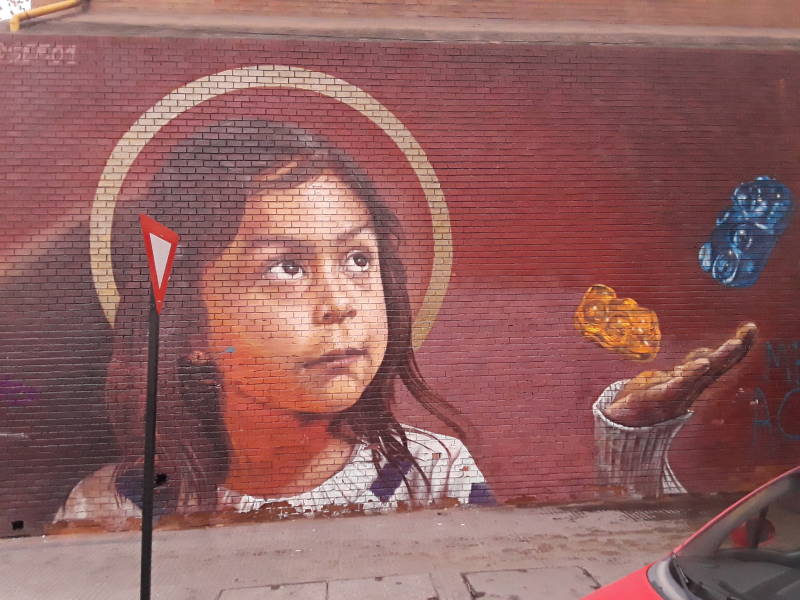
Onward Travel
Onward toValparaiso
From Santiago I traveled on to Valparaiso. The relatively small bus terminal at Pajaritos has frequent service to Valparaiso. It's the second-to-last stop westbound on the Red Line of the Metro.
